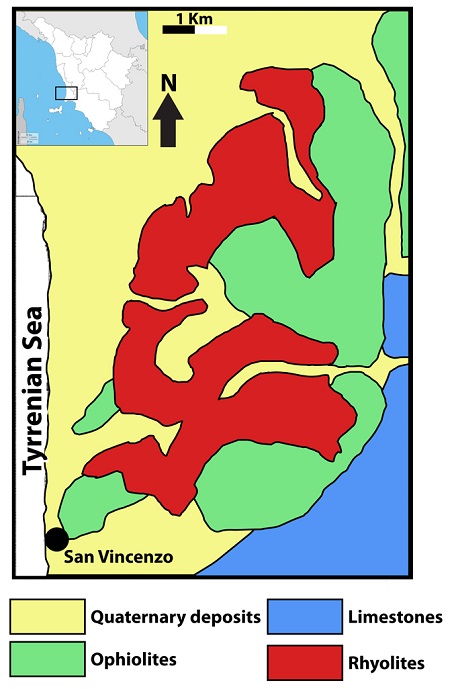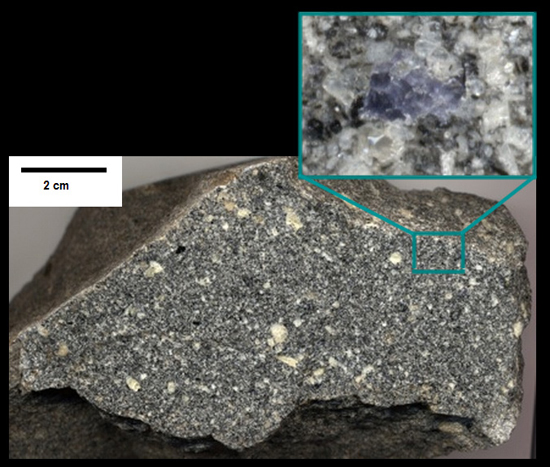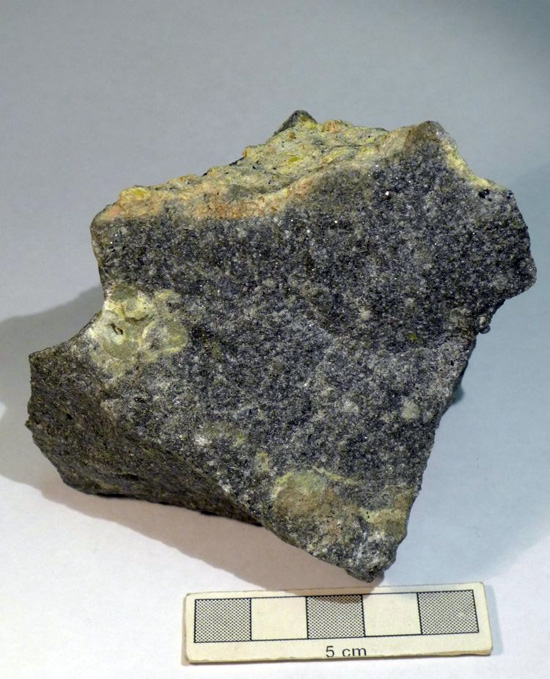The Campiglia mounts consist of a series of Cretaceous-Triassic calcareous formations belonging to the Tuscan nappe, overlaid by the Liguride formations (ophiolites) and neogene deposits. In this area are present not only the S.Vincenzo vo1canites, but also the Botro ai Marmi granite and some quartz- monzonitic veins between Valle S.Maria and Valle del Temperino. The volcanites (
) cover an area of about l0 km2 north of the town of S.Vincenzo, and consist of both fissural lava flows and lava domes, the latter aligned along a N-S direction from Torre Donoratico to Valle delle Rozze. All outcropping rocks are rhyolites in which are dispersed variable amounts of magmatic enclaves with latitic composition. Age data on these volcanites are quite scattered: 3.26 Ma (Rb/Sr,), 3.7 Ma (fission tracks) and 4.7 Ma (K/Ar).
S.Vincenzo volcanites have a porphiritic texture with glassy, cripto- or micro-crystalline groundmass. The phenocryst assemblage is dominated by quartz, alkali feldspar, plagioclase, and biotite with lesser amounts of cordierite; apatite, epidote, monazite, ilmenite, and zircon are present as accessory phases. Groundmass phases include plagioclase, biotite, apatite, zircon, and ilmenite. Some lavas contain clinopyroxene and orthopyroxene xenocrysts and latite enclaves. Some the authors report a division of the S.Vincenzo rhyolites into two groups: NMG (Not-Mixed Group) with low-Sr and MG (Mixed Group) with high-Sr. It is to note that the two groups reflect different geographical settings. In fact, MG and NMG samples represent the NNE and the SSW part, respectively, of the area covered by the volcanites.
At San Vincenzo pure anatectic rocks and rocks derived by interaction among pure anatectic and mantle derived melts were observed. Rocks cropping out east (MG) and west (NMG) of the main body (
) represent the mixed and the pure anatectic products, respectively. The anatectic rocks, represented by the NMG, derived from a source similar to Paleozoic garnet-bearing micaschists, through -40% of partial melting with a residual mineralogy pointing to a pressure grater than 4.0-6.0 Kb. The mixed rocks derived by a two end-member mixing process, with scarce, if any, fractional crystallization, between a felsic end-member similar to the NMG rocks and a mafic endmember presumably similar to Capraia magmas. Evolution of S.Vincenzo volcanism can be envisaged as follow: Mafic magmas were injected into a magma chamber filled by anatectic felsic melts. The chamber became stratified with the upper part constituted by felsic magmas and the lower part constituted by mixed magmas. The repeated injection of the mafic magma triggered sequential extrusions of the felsic magmas and of the mixed magmas. The first volcanic event filled the west part of the area, and, forming a structural high, prevented the second volcanie event to outpour on the same part. Consequently the MG magmas filled the east part of the area.
Cordierite phenocrysts.
San Vincenzo rhyolite sample. Violet cordierite crystals in the blue box.
San Vincenzo rhyolite sample with gray-green xenoliths.
• Peccerillo. A. Plio-Quaternary Volcanism in Italy. (2005)
• Poli.G, Perugini. D (2003): San Vincenzo volcanites. Per. Mineral.72.
Basalt
Plagioclase and quartz (colorless), biotite (brown) and small cordierite (with dusty-turbid appearance) crystals immersed in a vitreous ground mass. PPL image, 2x (Field of view = 7mm)
.jpg)
Plagioclase and quartz (colorless), biotite (brown) and small cordierite (with dusty-turbid appearance) crystals immersed in a vitreous ground mass. PPL image, 2x (Field of view = 7mm) |
.jpg)
Plagioclase and quartz (colorless), biotite (brown) and small cordierite (with dusty-turbid appearance) crystals immersed in a vitreous ground mass. PPL image, 2x (Field of view = 7mm) |
.jpg)
Plagioclase and quartz, biotite and small cordierite crystals immersed in a vitreous ground mass. XPL image, 2x (Field of view = 7mm) |
.jpg)
Plagioclase and quartz (colorless), biotite (brown) and small cordierite (with dusty-turbid appearance) crystals immersed in a vitreous ground mass. PPL image, 2x (Field of view = 7mm) |
.jpg)
Basaltic enclave PPL image, 2x (Field of view = 7mm) |
.jpg)
Plagioclase and quartz (colorless), biotite (brown) and small cordierite (with dusty-turbid appearance) crystals immersed in a vitreous ground mass. PPL image, 2x (Field of view = 7mm) |
.jpg)
Cordierite phenocryst (with dusty-turbid appearance) immersed in a vitreous ground mass. PPL image, 10x (Field of view = 2mm) |
.jpg)
Cordierite phenocryst immersed in a vitreous ground mass. XPL image, 10x (Field of view = 2mm) |
.jpg)
Plagioclase and quartz (colorless), biotite (brown) and small cordierite (with dusty-turbid appearance) crystals immersed in a vitreous ground mass. PPL image, 10x (Field of view = 2mm) |
.jpg)
Plagioclase and quartz (colorless), biotite (brown) and small cordierite (with dusty-turbid appearance) crystals immersed in a vitreous ground mass. PPL image, 10x (Field of view = 2mm) |
.jpg)
Plagioclase and quartz, biotite and small cordierite crystals immersed in a vitreous ground mass. XPL image, 10x (Field of view = 2mm) |
.jpg)
Plagioclase and quartz (colorless), biotite (brown) and small cordierite (with dusty-turbid appearance) crystals immersed in a vitreous ground mass. PPL image, 10x (Field of view = 2mm) |
.jpg)
Plagioclase and quartz (colorless), biotite (brown) and small cordierite (with dusty-turbid appearance) crystals immersed in a vitreous ground mass. PPL image, 10x (Field of view = 2mm) |
.jpg)
Plagioclase and quartz (colorless), biotite (brown) and small cordierite (with dusty-turbid appearance) crystals immersed in a vitreous ground mass. PPL image, 10x (Field of view = 2mm) |
.jpg)
Plagioclase and quartz, biotite and small cordierite crystals immersed in a vitreous ground mass. XPL image, 10x (Field of view = 2mm) |
.jpg)
Plagioclase and quartz (colorless), biotite (brown) and small cordierite (with dusty-turbid appearance) crystals immersed in a vitreous ground mass. PPL image, 10x (Field of view = 2mm) |
.jpg)
Plagioclase and quartz, biotite and small cordierite crystals immersed in a vitreous ground mass. XPL image, 10x (Field of view = 2mm) |
.jpg)
Plagioclase (with sieve texture) and quartz (colorless), biotite (brown) and small cordierite (with dusty-turbid appearance) crystals immersed in a vitreous ground mass. PPL image, 10x (Field of view = 2mm) |
.jpg)
Plagioclase and quartz (colorless), biotite (brown) and small cordierite (with dusty-turbid appearance) crystals immersed in a vitreous ground mass. PPL image, 10x (Field of view = 2mm) |
.jpg)
Plagioclase and quartz (colorless), biotite (brown) and small cordierite (with dusty-turbid appearance) crystals immersed in a vitreous ground mass. PPL image, 10x (Field of view = 2mm) |
.jpg)
Plagioclase and quartz (colorless), biotite (brown) and small cordierite (with dusty-turbid appearance) crystals immersed in a vitreous ground mass. PPL image, 10x (Field of view = 2mm) |
.jpg)
Plagioclase and quartz (colorless), biotite (brown) and small cordierite (with dusty-turbid appearance) crystals immersed in a vitreous ground mass. PPL image, 10x (Field of view = 2mm) |
.jpg)
Plagioclase and quartz (colorless), biotite (brown) and small cordierite (with dusty-turbid appearance) crystals immersed in a vitreous ground mass. PPL image, 10x (Field of view = 2mm) |
.jpg)
Plagioclase and quartz (colorless), biotite (brown) and small cordierite (with dusty-turbid appearance) crystals immersed in a vitreous ground mass. PPL image, 10x (Field of view = 2mm) |
.jpg)
Plagioclase and quartz (colorless), biotite (brown) and small cordierite (with dusty-turbid appearance) crystals immersed in a vitreous ground mass. PPL image, 10x (Field of view = 2mm) |
.jpg)
Cordierite phenocryst (with dusty-turbid appearance) immersed in a vitreous ground mass. PPL image, 10x (Field of view = 2mm) |
.jpg)
Cordierite phenocryst immersed in a vitreous ground mass. XPL image, 10x (Field of view = 2mm) |
.jpg)
Plagioclase and quartz (colorless), biotite (brown) and small cordierite (with dusty-turbid appearance) crystals immersed in a vitreous ground mass. PPL image, 10x (Field of view = 2mm) |
.jpg)
Plagioclase and quartz, biotite and small cordierite crystals immersed in a vitreous ground mass. XPL image, 10x (Field of view = 2mm) |
.jpg)
Plagioclase and quartz (colorless), biotite (brown) and small cordierite (with dusty-turbid appearance) crystals immersed in a vitreous ground mass. PPL image, 10x (Field of view = 2mm) |
.jpg)
Cordierite phenocryst with cyclic twinning, immersed in a vitreous ground mass. XPL image, 20x (Field of view = 1mm) |
.jpg)
Cordierite phenocryst with cyclic twinning, immersed in a vitreous ground mass. XPL (with Compensator plate) image, 20x (Field of view = 1mm) |
.jpg)
Cordierite phenocryst with cyclic twinning, immersed in a vitreous ground mass. XPL image, 20x (Field of view = 1mm) |
.jpg)
Cordierite phenocryst, partially altered by pinite. PPL image, 20x (Field of view = 1mm) |
.jpg)
Cordierite phenocryst with cyclic twinning, immersed in a vitreous ground mass. XPL image, 20x (Field of view = 1mm) |
.jpg)
Cordierite phenocryst with cyclic twinning, immersed in a vitreous ground mass. XPL (with Compensator plate) image, 20x (Field of view = 1mm) |
.jpg)
Cordierite phenocryst with cyclic twinning, immersed in a vitreous ground mass. XPL image, 20x (Field of view = 1mm) |
.jpg)
Cordierite phenocryst with cyclic twinning, immersed in a vitreous ground mass. XPL image, 20x (Field of view = 1mm) |
.jpg)
Cordierite phenocryst with cyclic twinning, immersed in a vitreous ground mass. XPL (with Compensator plate) image, 20x (Field of view = 1mm) |

.jpg)





.jpg)
.jpg)
.jpg)
.jpg)
.jpg)
.jpg)
.jpg)
.jpg)
.jpg)
.jpg)
.jpg)
.jpg)
.jpg)
.jpg)
.jpg)
.jpg)
.jpg)
.jpg)
.jpg)
.jpg)
.jpg)
.jpg)
.jpg)
.jpg)
.jpg)
.jpg)
.jpg)
.jpg)
.jpg)
.jpg)
.jpg)
.jpg)
.jpg)
.jpg)
.jpg)
.jpg)
.jpg)
.jpg)
.jpg)